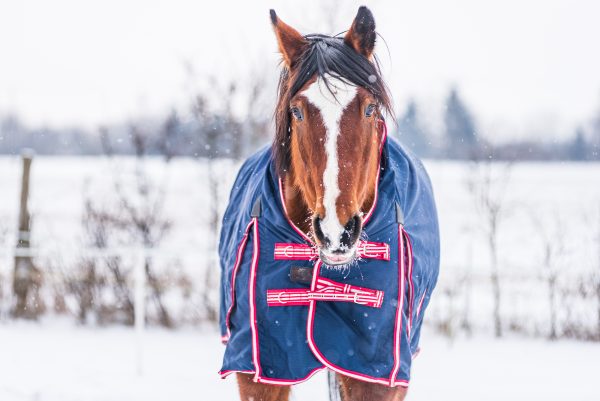
In the late fall, when the leaves fall off the trees and the nights get chilly, many of you will think about putting blankets on your horse and ponies. Blankets are handy for many reasons. A blanketed horse stays cleaner and this means it takes less time to groom him—and less time grooming means more time to ride! It can be difficult to fit in riding between school and homework, and it can be a real timesaver to arrive at the barn and be greeted by a clean horse.
But putting a blanket on your horse means more work for you, so you need to decide if your horse really needs to wear one. If your horse wears a blanket, you’ll have to check on him every day if he lives outside 24-7 to make sure the blanket hasn’t slipped. You need to look underneath the blanket to make sure it’s not rubbing him on the shoulders or in the wither area. You just can’t put a blanket on a horse and then forget about him.
And once you put a blanket on a horse, you can’t just take it off in the middle of the winter. If a horse wears a blanket, he won’t grow a woolly coat in preparation for winter weather and he’ll become used to the extra warmth he gets from it. He’ll have to wear a blanket for the entire winter season.
Let’s look at some types of horses that might need to wear a blanket. Do you recognize your four-legged friend?
Hard keepers
If your horse is a “hard keeper” in the winter months and it’s tough to keep weight on him, a blanket is an excellent idea. It will keep him cozy and he won’t waste energy trying to keep warm when it’s chilly outside.
Older horses
Older horses can benefit from wearing a blanket. Keeping warm takes a lot of energy and a blanket will keep the warmth generated from a horse’s body close to him. If an older horse has arthritis, a blanket will keep his aching joints warm. A blanket can also protect a horse from cold winds that can make him shiver.
Short-haired horses
Some breeds, including Thoroughbreds and Arabians, sometimes have short, fine coats. Some horses just don’t seem to grow shaggy, warm coats in the winter. These horses will feel warmer if they wear blankets.
Clipped horses
If you clip your horse in the winter, he should wear a blanket. A horse that has a full body clip will need to be blanketed almost all of the time. If you’ve just clipped your shaggy pony’s belly, he may not need to wear a blanket every day. Watch the weather. If it warms up, take off his blanket. You don’t want him to get overheated and sweaty underneath the blanket. If it gets nippy outside, put his blanket back on.
No blanket needed
If your horse is a shaggy sort and grows a thick winter coat, he probably doesn’t need a blanket. If he has plenty of shelter in his field or comes in at night, he doesn’t really need a blanket. If you don’t ride much in the winter months, he probably doesn’t need a blanket. Why? If you’re not riding him much, you’re not grooming him much. Brushing a horse removes dirt and oil from his coat which helps to keep him warm. You might look at your muddy horse and groan, but that mud is actually helping to keep him warm!
Fitting a blanket
It’s important to measure your horse before buying a blanket. Use a flat tape measure and start at the middle of your horse’s chest, and then work your way back to the middle of his tail. Most blankets come in three-inch increments, so if your horse measures 74 inches, go up an inch and buy a 75 inch blanket. Pony blankets usually measure 51 to 66 inches and horse blankets usually measure 69 to 84 inches.
Putting on a blanket
If your horse has never worn a blanket, let him sniff one before you throw it on his back and scare him to death. Then rub it over his back gently. If he stays calm, you can put on the blanket.
Fold the blanket in half and place it over his back and withers. Then slowly unfold it and cover his back and tail. Hook the chest fastenings first and then secure the belly straps. They shouldn’t be too loose. You don’t want your horse to get his legs caught in them.
If the blanket has rear leg straps, fasten them last. Loop one leg strap through the other one and then fasten it to the blanket as shown. This prevents the straps from rubbing your horse’s legs.
Does it fit?
You should be able to get your hands underneath the neck opening and move them around. You don’t want the blanket to be too tight around his neck. There should be room for his shoulder underneath the blanket. A blanket that is too tight can cause ugly rubs.
Taking off a blanket
Easy–reverse the procedure for putting on a blanket. Unfasten the leg straps first and fasten them back to the blanket so they don’t swing around. Then unfasten the belly straps. Finally, unhook the front fasteners. Fold the blanket from the back over the front of the blanket and then gently lift it off your horse’ back.


